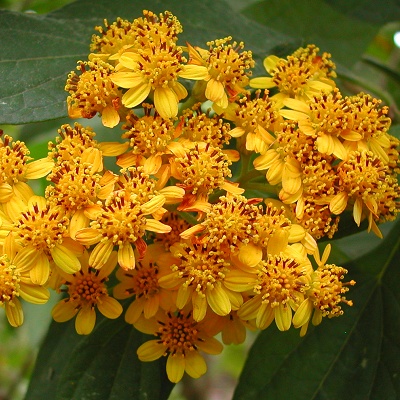| Home |
Strange Wonderful Things Rare and exotic plants |
 |
|---|
"Guatemalan Sunflower Bush"
Germinating the seeds
When to plant -- Plant them when you receive them for best results.
Soil -- This species likes soil that's high in organic matter/humus but that also drains well. A good mix is 2 parts potting soil to 1 part perlite. If your potting soil contains nutrients (check the label) do not mix in additional fertilizer.
Pot size - You may use small pots about 1.5 to 3 inches (4-8 cm) wide and 2.5 to 4 inches tall (6-10 cm). The pots should have drainage holes.
Fill the pots with the soil mix and water it until it is evenly moist (but not soggy). Sprinkle 1 or 2 seeds on top in each pot, and sprinkle just enough soil to barely cover the seeds (about 1/16 inch / 1.5 mm). Carefully moisten the top soil layer.
Until the seeds sprout, it's important not to let the surface soil dry out, so it's best to keep them at or near 100% humidity. If you place the pots in a plastic container or bag to maintain moisture, leave it open a crack to allow fresh air to enter. you may need to drip a few drops of water on them each day to keep the soil moist.
They sprout well at about 65 to 74° F (18-23°C). I have no information about how they will germinate outside that temperature range. I recommend placing a minimum/maximum thermometer near the pots.
Keep them in a bright spot out of direct sun. A fluorescent bulb kept 5 inches (12 cm) away provides the right amount of light. They should begin sprouting after 6 weeks, but allow up to 12 weeks for any slow ones.
Lighting -- Once your seeds sprout, move them to a bright spot, with protection from afternoon sun. You may use a fluorescent light kept a few inches (10 cm) away while your plants are young.
Adult plants prefer filtered sunlight or morning sun, with some protection from strong afternoon sun. The leaves seem to grow the largest in shade.
Watering: Once the seedlings are 3 weeks old, you may allow the surface soil to dry out, but aim to keep the rest of the soil evenly moist most of the time. Never let it dry out completely, but also don't keep it perpetually soggy.
If your water supply is very high in minerals (= "hard water"), it's best to use bottled water or rainwater.
Fertilizing -- This species appreciates regular feedings. Feed about every 2 months with a slow release (pelleted or organic) fertilizer. If your potting soil contains nutrients, your seedlings should need no feeding the first 3 weeks of growth.
It's normal for a few of the older leaves to occasionally turn yellow and drop, but if it seems excessive, the plant may need more fertilizer. Also check that the soil is not too dry down in the root zone.
It comes from mountain cloud forests of Guatemala, where daytime temperatures are usually in the 60s or 70s, and nights are cool but frost-free. It's possible that the plant might not thrive if temperatures regularly get above the low-80s, especially if nights are warm. It probably can survive a few degrees of frost, but since it flowers in winter, i recommend protecting it from freezing temperatures.
It might not thrive in very dry air - over about 40% humidity is recommended.
Repotting -- Once your seedlings are at least 3 inches tall (7 cm), you may repot them to larger containers about 1 quart (1 liter) in size. Repot gently and avoid letting the soil ball break apart. It's best to water the soil before repotting to keep the soil together. For the first week after repotting, shade from sun and give no fertilizer.
Repot again after 4 to 6 months, or plant in the ground in suitable areas. If you want to keep it in a pot, the final pot size depends on how large you choose to let it grow. You may prune your plant to any size that is convenient.
If you have any questions or problems, please contact me.
Have fun growing them!
- Jeff
Strange Wonderful Things
| Home |
Strange Wonderful Things Rare and exotic plants |
|
|---|---|---|
| Entire site Copyright 2003-2023 by Strange Wonderful Things, except as noted | ||

